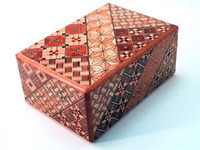

Total:131items
- Pottery & Porcelain (18)
- Lacquerware (4)
- Glasswork (2)
- Wood & Bamboo Work (19)
- Hakone Yosegi Zaiku: Hakone Marquetry
- Boshu Uchiwa: Boshu Fans
- Nikko-bori: Nikko carving
- Sasebo Koma (Sasebo Spinning Top)
- Shimoda Yanimatsu Zaiku (Shimoda Joinery of Oily Pine)
- Echizen Takeningyo (Bamboo Dolls)
- Osaka Senshu Kiri-dansu: Paulownia chest of drawers or wardrobes of Senshu, Osaka
- Kitayama Maruta: Japanese cedar logs
- Yodoegasa: Yodoe umbrella
- Atami Kusu Zaiku: Atami Camphor wood crafts
- Kawatsura Kokeshi Doll
- Itaya Zaiku: Itaya Bark Craft
- Yokohama Classic Furniture
- Hinaga Uchiwa: Hinaga Fan
- Torafu Takezaiku: Tiger Bamboo Work
- Tsuruzaiku: Woven Vine Craft
- Okawa Kumiko: Okawa Kumiko Wood Joinery
- Shuro Houki: Hemp-palm Broom
- Furyumen: Wood Carving Mask
- Leather Work (1)
- Papermaking (13)
- Textile (20)
- Dyeing products (5)
- Masonry (1)
- Metal Work (11)
- Stationery (4)
- Livingware (3)
- Accessory (4)
- Toys & Entertainment (14)
- Interior (2)
- Other crafts (10)

 |
Main Production Site:Kanagawa |
 《Characteristics》
《Characteristics》The mountains in Hakone area are known to be one of the areas with wide variety of trees, along with Arashiyama in Kyoto and Daisen in Tottori. Hakone Yosegi Zaiku, or Hakone marquetry, is one of the traditional handicrafts in Hakone, generally called Hakone Zaiku. It is a very unique type of woodwork in Japan, which is developed receiving the benefits from the rich natural resources in Hakone. This craftwork creates a detailed geometric pattern or mosaic with pieces of different kinds of woods, making the most of the natural tinges of the material. It is often used for small boxes to keep jewelleries, for example.
There are two kinds of Hakone Zaiku: Hiki-mono (lathe work) and Sashi-mono (cabinetwork). Hiki-mono is a type of craftwork created by using a turning lathe, and it includes circular trays, bowls and circular dining tables. Since Meiji period, this technique has also been used to make toys for children. The products of Sashi-mono are mainly boxes whose surfaces are decorated with wooden mosaic and inlaid work.
[A country designated traditional craft (Designated by the Minister of Economy, Trade and Industry)]
Photos by Hakone Maruyama Inc.
Translation: Moe Shoji, reviewed by Yukiko Ueno
Check It Out!
Hakone Marquetry products are available at online shop WA-YOU-EN.

| Materials | Natural wood, natural lacquer and glue |
|---|---|
| Crafting Processes | Pieces of different colours of wood are planed to the desired thickness. They are layered according to the pattern and glued together. The layered material is cut with a handsaw in order to produce a unit pattern, using the marquetry frame which is unique to this technique.
The unit patterns are carefully planed and smoothed. To create a larger pattern, each of these completed unit patterns is glued on one side. The unit patterns are combined and bound together with a thread. These units glued together are cut with a handsaw in order to enlarge the pattern. The patterns cut into many pieces are assembled and glued again. By repeating this process, the pattern becomes bigger and bigger. The resulting large piece of wood is called Tanegi. Tanegi is planed away and a thin sheet of wood is produced. This sheet of wood is called Zuku. Zuku is usually curled when it is planed off from the wood; therefore, it is ironed to flatten and it is now ready to be used for decorating a small box. |
| History | It is said that the origin of Hakone Zaiku dates back to early Heian period (8th-12th century). It became common as a side job for palanquin bearers in Edo period (17th-19th century) and the products were sold in hot spring resorts and tea shops on the highways.
This technique of Hakone Yosegi Zaiku, or Hakone marquetry, is invented in the late Edo period by Nihei Ishikawa (1790-1850) who lived in Hatajuku, Hakone-machi. Hakone Yosegi Zaiku is designated by the Minister of Economy, Trade and Industry as a traditional craft in Japan in May 1984. |
◆Exhibition / Showcase
Hakone Maruyama Inc. Head Office
Hakone 17,
Hakone-machi, Ashigarashimo-gun
Kanagawa,
250-0521
Japan
Telephone: +81(0)460-83-6604
Fax: +81(0)460-83-7825
Open everyday, 9.00-17.00
*Hakone Marquetry products are available at online shop WA-YOU-EN.



